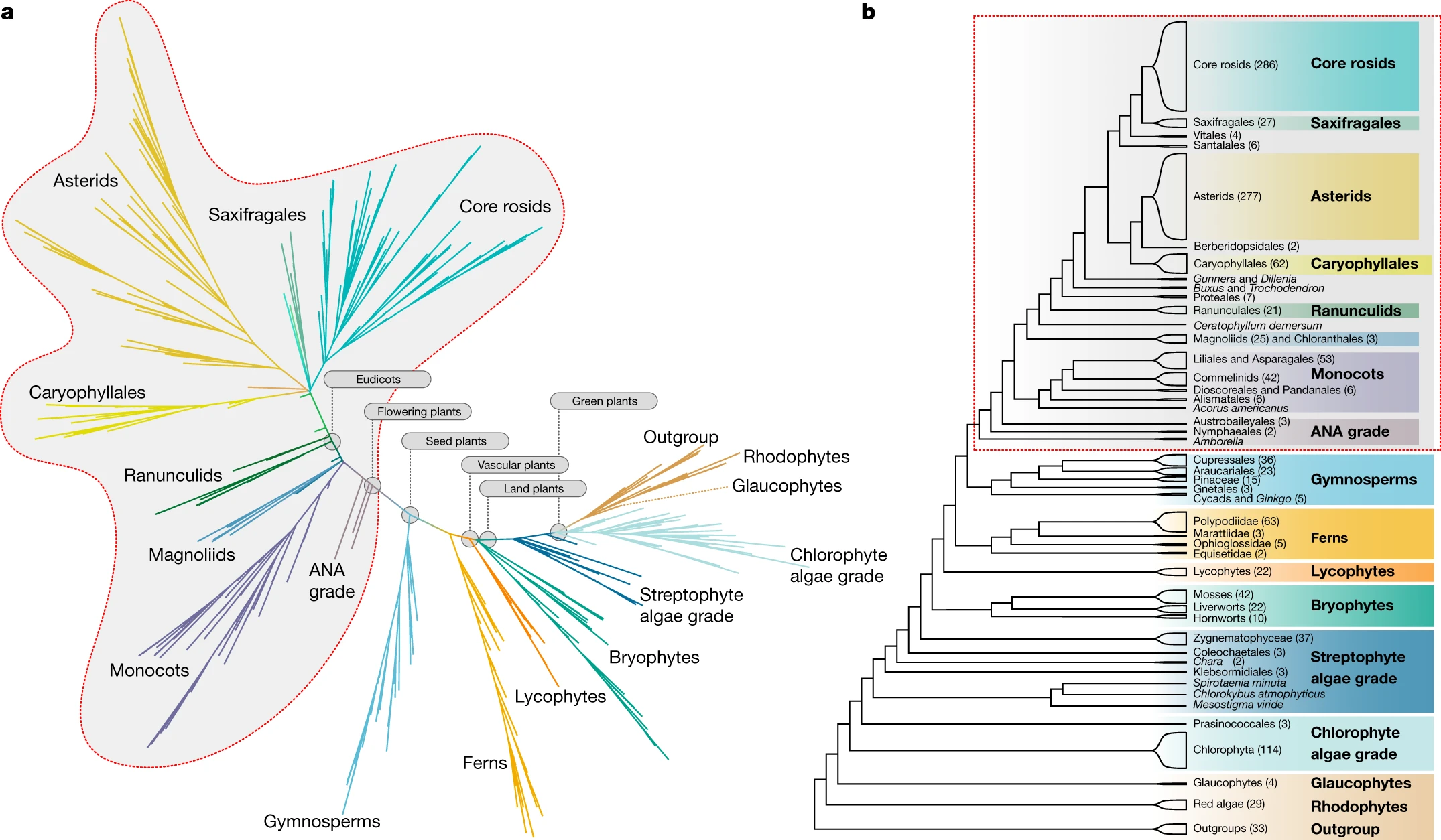19.2: Introduction to the Evolution of the Embryophyta
- Page ID
- 29595
\( \newcommand{\vecs}[1]{\overset { \scriptstyle \rightharpoonup} {\mathbf{#1}} } \)
\( \newcommand{\vecd}[1]{\overset{-\!-\!\rightharpoonup}{\vphantom{a}\smash {#1}}} \)
\( \newcommand{\id}{\mathrm{id}}\) \( \newcommand{\Span}{\mathrm{span}}\)
( \newcommand{\kernel}{\mathrm{null}\,}\) \( \newcommand{\range}{\mathrm{range}\,}\)
\( \newcommand{\RealPart}{\mathrm{Re}}\) \( \newcommand{\ImaginaryPart}{\mathrm{Im}}\)
\( \newcommand{\Argument}{\mathrm{Arg}}\) \( \newcommand{\norm}[1]{\| #1 \|}\)
\( \newcommand{\inner}[2]{\langle #1, #2 \rangle}\)
\( \newcommand{\Span}{\mathrm{span}}\)
\( \newcommand{\id}{\mathrm{id}}\)
\( \newcommand{\Span}{\mathrm{span}}\)
\( \newcommand{\kernel}{\mathrm{null}\,}\)
\( \newcommand{\range}{\mathrm{range}\,}\)
\( \newcommand{\RealPart}{\mathrm{Re}}\)
\( \newcommand{\ImaginaryPart}{\mathrm{Im}}\)
\( \newcommand{\Argument}{\mathrm{Arg}}\)
\( \newcommand{\norm}[1]{\| #1 \|}\)
\( \newcommand{\inner}[2]{\langle #1, #2 \rangle}\)
\( \newcommand{\Span}{\mathrm{span}}\) \( \newcommand{\AA}{\unicode[.8,0]{x212B}}\)
\( \newcommand{\vectorA}[1]{\vec{#1}} % arrow\)
\( \newcommand{\vectorAt}[1]{\vec{\text{#1}}} % arrow\)
\( \newcommand{\vectorB}[1]{\overset { \scriptstyle \rightharpoonup} {\mathbf{#1}} } \)
\( \newcommand{\vectorC}[1]{\textbf{#1}} \)
\( \newcommand{\vectorD}[1]{\overrightarrow{#1}} \)
\( \newcommand{\vectorDt}[1]{\overrightarrow{\text{#1}}} \)
\( \newcommand{\vectE}[1]{\overset{-\!-\!\rightharpoonup}{\vphantom{a}\smash{\mathbf {#1}}}} \)
\( \newcommand{\vecs}[1]{\overset { \scriptstyle \rightharpoonup} {\mathbf{#1}} } \)
\( \newcommand{\vecd}[1]{\overset{-\!-\!\rightharpoonup}{\vphantom{a}\smash {#1}}} \)
\(\newcommand{\avec}{\mathbf a}\) \(\newcommand{\bvec}{\mathbf b}\) \(\newcommand{\cvec}{\mathbf c}\) \(\newcommand{\dvec}{\mathbf d}\) \(\newcommand{\dtil}{\widetilde{\mathbf d}}\) \(\newcommand{\evec}{\mathbf e}\) \(\newcommand{\fvec}{\mathbf f}\) \(\newcommand{\nvec}{\mathbf n}\) \(\newcommand{\pvec}{\mathbf p}\) \(\newcommand{\qvec}{\mathbf q}\) \(\newcommand{\svec}{\mathbf s}\) \(\newcommand{\tvec}{\mathbf t}\) \(\newcommand{\uvec}{\mathbf u}\) \(\newcommand{\vvec}{\mathbf v}\) \(\newcommand{\wvec}{\mathbf w}\) \(\newcommand{\xvec}{\mathbf x}\) \(\newcommand{\yvec}{\mathbf y}\) \(\newcommand{\zvec}{\mathbf z}\) \(\newcommand{\rvec}{\mathbf r}\) \(\newcommand{\mvec}{\mathbf m}\) \(\newcommand{\zerovec}{\mathbf 0}\) \(\newcommand{\onevec}{\mathbf 1}\) \(\newcommand{\real}{\mathbb R}\) \(\newcommand{\twovec}[2]{\left[\begin{array}{r}#1 \\ #2 \end{array}\right]}\) \(\newcommand{\ctwovec}[2]{\left[\begin{array}{c}#1 \\ #2 \end{array}\right]}\) \(\newcommand{\threevec}[3]{\left[\begin{array}{r}#1 \\ #2 \\ #3 \end{array}\right]}\) \(\newcommand{\cthreevec}[3]{\left[\begin{array}{c}#1 \\ #2 \\ #3 \end{array}\right]}\) \(\newcommand{\fourvec}[4]{\left[\begin{array}{r}#1 \\ #2 \\ #3 \\ #4 \end{array}\right]}\) \(\newcommand{\cfourvec}[4]{\left[\begin{array}{c}#1 \\ #2 \\ #3 \\ #4 \end{array}\right]}\) \(\newcommand{\fivevec}[5]{\left[\begin{array}{r}#1 \\ #2 \\ #3 \\ #4 \\ #5 \\ \end{array}\right]}\) \(\newcommand{\cfivevec}[5]{\left[\begin{array}{c}#1 \\ #2 \\ #3 \\ #4 \\ #5 \\ \end{array}\right]}\) \(\newcommand{\mattwo}[4]{\left[\begin{array}{rr}#1 \amp #2 \\ #3 \amp #4 \\ \end{array}\right]}\) \(\newcommand{\laspan}[1]{\text{Span}\{#1\}}\) \(\newcommand{\bcal}{\cal B}\) \(\newcommand{\ccal}{\cal C}\) \(\newcommand{\scal}{\cal S}\) \(\newcommand{\wcal}{\cal W}\) \(\newcommand{\ecal}{\cal E}\) \(\newcommand{\coords}[2]{\left\{#1\right\}_{#2}}\) \(\newcommand{\gray}[1]{\color{gray}{#1}}\) \(\newcommand{\lgray}[1]{\color{lightgray}{#1}}\) \(\newcommand{\rank}{\operatorname{rank}}\) \(\newcommand{\row}{\text{Row}}\) \(\newcommand{\col}{\text{Col}}\) \(\renewcommand{\row}{\text{Row}}\) \(\newcommand{\nul}{\text{Nul}}\) \(\newcommand{\var}{\text{Var}}\) \(\newcommand{\corr}{\text{corr}}\) \(\newcommand{\len}[1]{\left|#1\right|}\) \(\newcommand{\bbar}{\overline{\bvec}}\) \(\newcommand{\bhat}{\widehat{\bvec}}\) \(\newcommand{\bperp}{\bvec^\perp}\) \(\newcommand{\xhat}{\widehat{\xvec}}\) \(\newcommand{\vhat}{\widehat{\vvec}}\) \(\newcommand{\uhat}{\widehat{\uvec}}\) \(\newcommand{\what}{\widehat{\wvec}}\) \(\newcommand{\Sighat}{\widehat{\Sigma}}\) \(\newcommand{\lt}{<}\) \(\newcommand{\gt}{>}\) \(\newcommand{\amp}{&}\) \(\definecolor{fillinmathshade}{gray}{0.9}\)There are four major evolutionary groups of land plants: Bryophytes, Seedless Vascular Plants (SVPs), Gymnosperms, and Angiosperms. These groupings represent major changes in plant structure and life history characteristics over the course of time that coincide with major changes in the evolution of the Earth, as a whole. The classification “embryophytes” refers to the evolution of the embryo, a zygote that is retained and nourished by the female gametophyte as it grows.
Embryophytes share many common features, most corresponding to the selective pressures from the initial movement onto land. The embryo is one of these, providing higher likelihood of success for offspring in a new, harsh environment. In addition to the embryo, all plants have the same basic life cycle: alternation of generations. Much like the marine algae, the first plants were living in an environment where they needed to increase their chances of reproductive events. Multicellular stages on both sides of the life cycle increases the number of reproductive propagules. All plants are also multicellular, with tissues and multicellular gametangia.
Other adaptations to life on land include the desiccation-resistant compound sporopollenin. This is found in the cell walls of spores of early land plants and in pollen of seed plants, hence the name sporo - pollen - in. It is also found in the cell walls of a few green algae. On the exterior, plants are surrounded by a waxy cuticle that helps protect them from their outer environment.
Much like their green algal predecessors, plants store their carbohydrates as starch inside plastids, plastids with two membranes (the result of primary endosymbiosis), cell walls containing cellulose, and have the pigments chlorophyll a, chlorophyll b, and carotenoids. For this reason, along with genetic sequencing, land plants and green algae are grouped together in the Viridiplantae.
Phylogeny: A Hypothesis on Evolutionary Relationships
The diagram on the next page shows the nested relationships between lineages in the descendents of primary endosymbiosis. This diagram is a hypothesis for how these different lineages are related, based on a large amount of genetic information that was analyzed through the One Thousand Plant Transcriptomes Initiative (2019). In this project, they compared the genetic products (RNA transcripts) from over 1,000 species. The phylogeny summarizes their findings by grouping the organisms by who was most similar.
The red algae were most similar to the outgroup--a group thought to be prior to primary endosymbiosis--while the angiosperms were the least similar to the outgroup. It is most likely that these differences are because the angiosperms evolved later, after many differences had accumulated in their evolutionary history, differentiating them from the outgroup. The conclusions we draw about relatedness of major groups of plants and when these groups of plants evolved can also be supported by the fossil record. Rocks that fossils are found in can be dated and we can use morphological features found in those fossils to link them to extant plants.
We have no way of knowing the true evolutionary history of organisms, as we were not there to witness the events. However, we can use an assemblage of data to develop hypotheses about how the events occurred. The evolutionary groupings used in this lab manual are based largely on the findings from the following phylogeny.
As you work through the material today, reference the phylogeny and try to make sense of how it depicts the relationships described in the lab. Note the nested groups discussed. At the end, try to make your own simplified phylogeny.
Diagram below: Phylogenetic inferences of major clades; from One thousand plant transcriptomes and the phylogenomics of green plants by Leebens-Mack, J.H., Barker, M.S., Carpenter, E.J. et al. Nature 574, 679–685 (2019) [Open Access]



